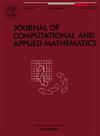保持平面五次曲线勾股定理性质的控制点修正
IF 2.1
2区 数学
Q1 MATHEMATICS, APPLIED
Journal of Computational and Applied Mathematics
Pub Date : 2024-10-01
DOI:10.1016/j.cam.2024.116301
引用次数: 0
摘要
虽然平面毕达哥拉斯曲线(PH)与标准伯恩斯坦-贝塞尔表示法兼容,但随意修改控制点会损害其 PH 性质。本研究的重点是确定控制点位移,以确保给定的平面 PH 曲线仍然是 PH 曲线。具体而言,对于平面五元 PH 曲线 r(t),t∈[0,1],研究表明,两个控制点的有限多个同时位移会产生修正的五元 PH 曲线,并将其确定为二次方程和三次方程的解。作为一种更实用的方法,我们考虑了通过单个内部控制点的位移来修正 r(0)=0 和 r(1)=1 的典型 PH 五边形,并利用其余内部控制点来最小化与原始 PH 五边形的偏差。正如几个示例所示,这种方法提供了一种高效、直观的手段,可在平面 PH 五边形曲线空间内实现合理的形状修改。本文章由计算机程序翻译,如有差异,请以英文原文为准。
Control point modifications that preserve the Pythagorean–hodograph nature of planar quintic curves
Although planar Pythagorean–hodograph (PH) curves are compatible with the standard Bernstein–Bézier representations, freely modifying the control points will compromise their PH nature. The present study focuses on identifying control point displacements that ensure a given planar PH curve remains a PH curve. In particular, for planar quintic PH curves , it is shown that finitely-many simultaneous displacements of two control points yield modified quintic PH curves, identified as the solutions of quadratic and cubic equations. As a more practical approach, modification of PH quintics in canonical form with and by the displacement of a single interior control point is considered, with the remaining interior control points being used to minimize a measure of deviation from the original PH quintic. As illustrated by several examples, this approach provides an efficient and intuitive means of effecting reasonable shape modifications within the space of planar quintic PH curves.
求助全文
通过发布文献求助,成功后即可免费获取论文全文。
去求助
来源期刊
CiteScore
5.40
自引率
4.20%
发文量
437
审稿时长
3.0 months
期刊介绍:
The Journal of Computational and Applied Mathematics publishes original papers of high scientific value in all areas of computational and applied mathematics. The main interest of the Journal is in papers that describe and analyze new computational techniques for solving scientific or engineering problems. Also the improved analysis, including the effectiveness and applicability, of existing methods and algorithms is of importance. The computational efficiency (e.g. the convergence, stability, accuracy, ...) should be proved and illustrated by nontrivial numerical examples. Papers describing only variants of existing methods, without adding significant new computational properties are not of interest.
The audience consists of: applied mathematicians, numerical analysts, computational scientists and engineers.

 求助内容:
求助内容: 应助结果提醒方式:
应助结果提醒方式:


